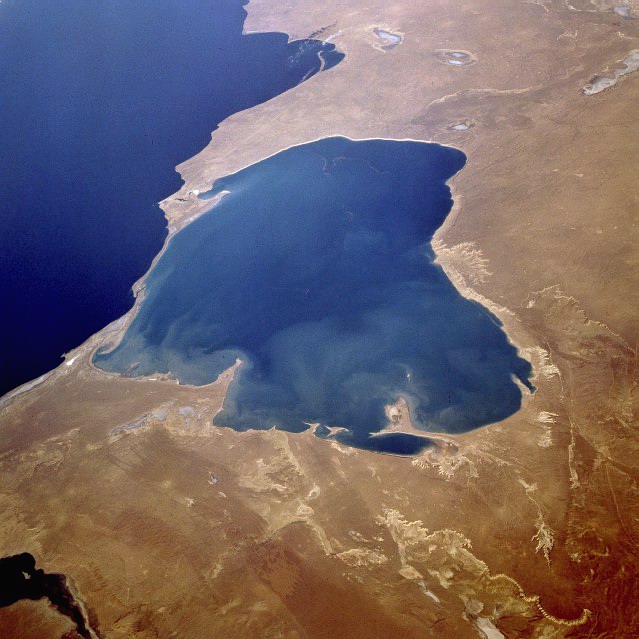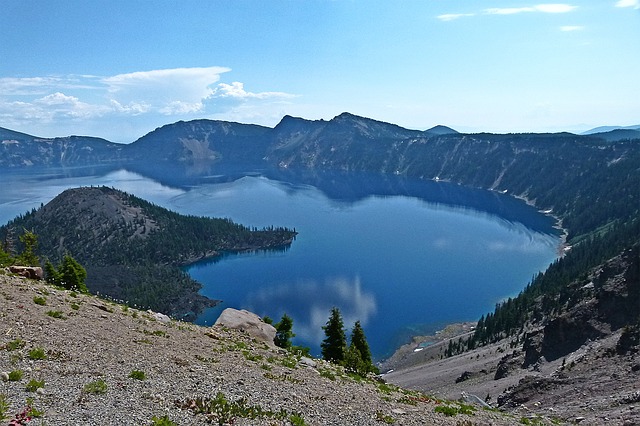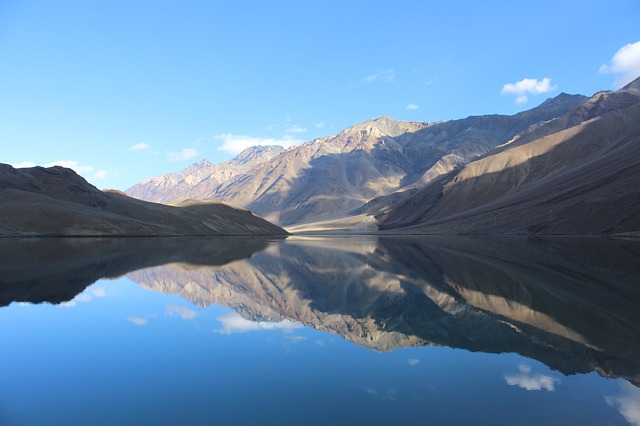A lake is a body of water surrounded by land. Lakes are generally quite large but can be as small as a pond. Some lakes like the Caspian sea cover 371,000 square kilometers of area. Lakes are classified in a bunch of different ways. This article discusses the types of lakes based on origin. It should be noted that lake classification may differ from source to source.
Types of Lakes
A. Lakes formed by Earth movement
A1. Tectonic Lakes
Tectonic lakes are formed when the depressions are created as the Earth’s crust bends, warps, or fractures. Caspian sea is an example of a tectonic lake. It is the largest lake in the world.

A2. Rift valley Lakes
When the land between two faults on the Earth’s surface sinks and water collects in the trough over time, rift valley lakes are formed. Examples include the lakes in the East African Rift Valley like Lake Tanganyika and Lake Mweru.
B. Lakes formed by deposition
B1. Ox-bow Lakes
These lakes are formed during or after a flood when a river changes its course, shortening it and leaving behind a meandering loop. These loops form a lake known as Ox-bow lake.
B2. Coastal Lagoons
Coastal Lagoons are water bodies separated from the ocean by narrow barriers of sand, mud, or reef. They are usually shallowly created by the wind and wave action over time. Example – Chilika lake in Odisha, India.

B3. Lakes created by landslides and avalanches
These lakes are formed when a landslide or avalanche occurs in a river valley partially or completely damming a river. The river eventually finds a way down. The lakes formed are usually short-lived and disappear as the debris is cleared by the pressure of water.
C. Lakes formed due to volcanic activity
C1. Caldera or Crater Lakes
A caldera is a natural depression formed on a volcano after the eruption. The top and the sides collapse inward as the magma chamber empties, creating a depression. A caldera has steep sides and is roughly circular in shape.

In extinct and dormant volcanoes, these calderas are filled by rain creating caldera lakes.
C2. Lakes formed due to subsidence of the volcanic land surface
The lava flow may form fake hollow crusts as it cools. If this crust collapses, depressions form in which lakes can develop.
D. Lakes formed due to Glacial activity
Prerequisite knowledge
Moraine
General term for accumulated sediments brought by the flowing glacier.
Outwash plain
Plain extending from the foot of a glacier composed of sediments brought by the meltwater.
D1. Cirque Lake or tarn
Cirque, also known as Corrie is a landform that forms due to glacial erosion. Cirques are amphitheater-shaped and have steep cliff walls on three sides. The fourth side is where the glacier is flowing to. When the water deposits in the cirques after the glacier recedes or disappears, cirque lakes or tarns are formed. Chandra Taal in Himachal Pradesh, India is an example of a cirque lake.

D2. Kettle Lakes
The stagnant dead ice blocks in a previously glaciated area are surrounded and buried by the sediments deposited by meltwater in the outwash plain. When this dead ice melts, kettle lakes are formed. Example – Heart Lake in Ontario, Canada.
D3. Rock hollow Lakes
These lakes are formed when the glacier erodes the surface and water accumulates in the depression. These lakes are commonly found in Scandinavian countries, Canada, and the other Arctic regions. In Finland, it is estimated that there are over 35,000 such lakes.
D4. Ribbon Lakes
When the glacier and its accompanying rocks erode the underlying soft rocks, deepening the valley floor. The depression created is surrounded by hard rocks. When the glacier recedes or disappears, this depression is filled with rainwater creating ribbon lakes. Ribbon lakes are long finger-shaped lakes, usually deep. Example – Windermere lake in England.
D5. Lakes formed due to morainic damming
These types of lakes are formed due to damming by morainic debris across a glacier valley.
E. Lakes formed by erosion
E1. Karst Lakes
Karst regions have rocky ground made of water-soluble limestone. Rainwater dissolves limestone and seeps underground and forms channels of flow. Over time underground caverns are formed which may contain narrow lakes. The limestone roof in the cavern sometimes collapses and exposes the underground lakes. The extent of the exposed lakes depends on the season and rainfall. Example – Eichener See in Germany.
E2. Wind deflated Lakes
These lakes are formed in deserts when the sand is washed away by the strong desert winds. This may create a hollow or depression that reaches the ground water-level forming lakes. The water in these lakes is a mix of groundwater and rainwater. These lakes are usually very saline. Qattara depression in Egypt was formed by wind erosion assisted by salt weathering.
F. Lakes formed by Humans and Animals
F1. Dam reservoirs
Dam reservoirs are artificial lakes created for storing water for power generation in the future. Some prime examples are Lake Volta in Ghana, Hirakud reservoir in Odisha, India.
F2. Beaver lakes
Beavers are known for constructing dams on rivers and streams with mud, stones, and timber. These dams may give rise to lakes which are often short-lived.
Types of Lakes based on water type
Freshwater Lakes
The lakes which contain a low concentration of dissolved salts are known as freshwater lakes. Freshwater is accumulated by precipitation, melting of ice, or groundwater seepage.
Saline Lakes
Saline lakes contain a high concentration of dissolved salts. These lakes are generally found in areas with a high average annual rate of evaporation.
Brackish water Lakes
These lakes have a medium concentration of dissolved salts.
Some interesting facts
- Caspian sea is the largest lake in the world. It has an area of approximately 371,000 square kilometers.
- Lake Volta in Ghana is the largest man made lake in the world. It is a dam reservoir with a surface area of 8,500 square kilometers.
- Lake Superior is the second largest lake in the world. It is still about one-fifth the size of Caspian sea.
- There are lakes on other planets and astronomical objects also, but they may be of other chemical substances.
Read more